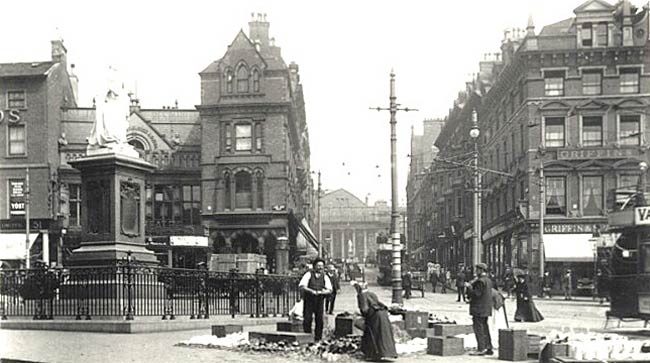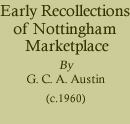
Market traders, c.1905.
I had now covered the main section of the Market, which ended at a wide roadway, which, a few years previously, had been cut through the stalls, to connect Market Street with Wheeler Gate. By the side of the road stood a line of cabs, four wheelers and hansoms. They were a shabby lot, like the drivers, who were public characters known to everybody by name. Every vehicle had its owner's name painted conspicuously on it.
Across this road, on a large triangular site, was the remaining part of the Market, which contained much of interest. A few nurserymen's stalls, crowded out of the main section, came first, and behind these was the Bird Market, so called, though the name did not do it justice. The birds were mostly fowls, with chickens and ducklings in Spring. Canaries and other cage birds, even a parrot or two, were also on sale; but there were no budgerigars. Besides birds, there were dogs in great variety, and cages of yelping puppies. Anyone who had a dog to sell came here and stood with the animal on a lead, or in his arms, until accosted by a buyer. The toll keeper had a tiresome job extracting coppers from these men, many of whom were Bulwell Colliers. There were other animals also for sale —rabbits, white mice and tortoises, and occasionally, a goat. The great feature of this area was the famous Pot Market, the delight of thrifty housewives. Thousands of pieces of china were laid out on the cobbles in jumbled heaps, with narrow paths between, where one walked warily for fear of kicking the crockery. Customers rummaged, without interference, in search of articles to match some already owned. It was possible, by patience and many visits, to make up a tea or dinner service, for a fraction of the shop price. Of course, the pieces were all "seconds", but the defects were trifling, and the joy of the hunt was great. The vendors kept up a merry clatter demonstrating that the goods were free from cracks. The "King" of the Market, a tall old man with a ragged beard, kept up a monotonous chant of "Sort 'em out at your own price! All sound and perfect, ladies!" Some years later, the Queen Victoria statue was erected here. I remember attending the unveiling ceremony, attired in frock coat and silk hat, without which, in those days, I should have been conspicuous. Mrs. Cappocci, the Ice Cream Queen, reigned nearby.
Alongside the Pot Market was a row of refreshment booths, the forerunners of the snack-bar, though one did not eat at a counter, or perch on a stool. The meal was taken seated on a backless form at a narrow oilcloth-covered table. A surprising number of people could be crowded in, and the menu ranged from a penny cup of tea to a "cut off the joint with two vegs". Cooking, serving, eating and washing-up were all done in the same small enclosure, and everything was cleared off the site when business for the day was done. A big "outside" trade was carried on by taking food and drink to stall-holders who could not leave their stalls. On this site also, flourished the chip-potato sellers. Their stalls were large square frames of wood-work, enclosed in white cloths, with narrow counters on two sides. Inside the enclosure were batteries of coke stoves, heating great cauldrons of boiling fat. Pans of pure lard were ostentatiously displayed, as a guarantee that cheap vegetable oil was scorned. The white chips were brought from a nearby depot—generally the proprietor's house—in large galvanised baths. The tons of potatoes used, were, of course, peeled by hand. Every few minutes a half bathful of chips was plunged into the boiling fat, with loud sizzlings and clouds of fumes. By the successive use of a number of pans, timed according to the state of trade, a continuous supply of golden-brown fingers, hot and crisp, was kept ready for sale. How good and satisfying they were! For a penny one got a paper boatfull with salt and vinegar to taste. Customers stood in the glow of the furnaces in winter or walked away in warmer weather, with the cheapest and best meal to be found. But there were still more savoury delights. On half-a-dozen small stalls, cooked shell-fish,— mussels, cockles, winkles,—were attractively set out on little plates, garnished with parsley. These were eaten with the fingers, standing at the stall. Nearby, there were hot pies, which must be eaten with a spoon. "Do you like the fish first, or do you prefer to start with hot peas ?" Either way, the result was a thirst, and just across the road was the "Talbot", and on the opposite side the "Bell". A dozen more houses of call stood within a stone's throw.
One or two odds and ends completed this far corner of the Market. On Wednesday mornings, before the 'chip' stalls were erected, the ground was occupied by a collection of second-hand furniture, which was quickly sold and dispersed. An old man with an arm-chair weighing machine stood near. He laboriously wrote out tickets, giving correct weight, for a penny. The last stall of all housed a galvanic battery, presided over by a white-bearded, stone-deaf old man. Clients stood solemnly round gripping brass handles, with the assurance that the tingling sensation they experienced, would relieve their various maladies. "Old Earp" was a pioneer, and the treatment must have had some effect, as people came to him again and again.
I had to make a number of visits to this part of the Market in order to accurately record the names and locations of all these miscellaneous small traders; then, having done so, I turned back towards the Exchange. Here I found a very attractive section of the Market, which was detached from the main body. Extending in a long line on South Parade and its extension, the Poultry, were flower stalls, occupying a narrow strip of the pavement. They were a pretty sight, especially in the Spring.
